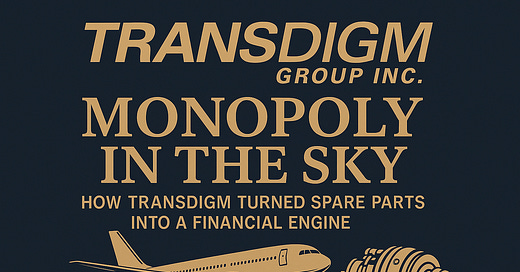TransDigm
Monopoly in the Sky: How TransDigm Turned Spare Parts into a Financial Engine
At the heart of the aerospace industry lies a company that has mastered the art of turning the peripheral into the essential. TransDigm doesn’t make engines or fuselages—but it owns the intellectual property behind thousands of small, highly engineered components that are critical to aircraft operation. This is a business model that resembles the world’s most profitable niches: invisible to the end user, indispensable to the customer, and nearly impossible to replicate.
What sets TransDigm apart isn’t just its focus on the aftermarket—where gross margins approach 90% and pricing power is unmatched—but also its organizational philosophy. With a lean, decentralized structure and an aggressive acquisition strategy, the company has spent decades consolidating a fragmented supplier base into a cash-generating machine. Its EBITDA has compounded at 26% annually for the past 20 years, despite operating in a low-growth, capital-intensive industry.
This level of profitability hasn’t gone unnoticed. TransDigm has faced multiple government inquiries, including a high-profile Senate hearing over excessive markups on military contracts. But these controversies have only highlighted the depth of its competitive moat. Its parts are so deeply embedded in the certification processes and safety systems of modern aircraft that replacing them is both expensive and time-consuming.
The real power of TransDigm lies in asymmetry. Airlines may spend hundreds of millions on fuel and labor, but the cost of a proprietary $300 component—when failure means grounded aircraft and lost revenue—is a rounding error. And yet, it’s in these overlooked corners of the aviation value chain that TransDigm thrives, quietly extracting returns that few companies in any industry can match.




